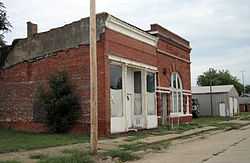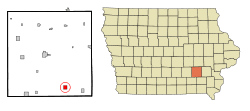Ollie, Iowa
| Ollie, Iowa | |
|---|---|
| City | |
 | |
 Location of Ollie, Iowa | |
| Coordinates: 41°11′52″N 92°5′39″W / 41.19778°N 92.09417°WCoordinates: 41°11′52″N 92°5′39″W / 41.19778°N 92.09417°W | |
| Country |
|
| State |
|
| County | Keokuk |
| Area[1] | |
| • Total | 0.99 sq mi (2.56 km2) |
| • Land | 0.99 sq mi (2.56 km2) |
| • Water | 0 sq mi (0 km2) |
| Elevation | 781 ft (238 m) |
| Population (2010)[2] | |
| • Total | 215 |
| • Estimate (2012[3]) | 213 |
| • Density | 217.2/sq mi (83.9/km2) |
| Time zone | Central (CST) (UTC-6) |
| • Summer (DST) | CDT (UTC-5) |
| ZIP code | 52576 |
| Area code(s) | 641 |
| FIPS code | 19-59070 |
| GNIS feature ID | 0459858 |
Ollie is a city in Keokuk County, Iowa, United States. The population was 215 at the 2010 census. Originally known as Hemingford, the town voted to change the name to Ollie in 1892.
Geography
Ollie is located at 41°11′52″N 92°5′39″W / 41.19778°N 92.09417°W (41.197685, -92.094125).[4]
According to the United States Census Bureau, the city has a total area of 0.99 square miles (2.56 km2), all of it land.[1]
Demographics
| Historical populations | ||
|---|---|---|
| Year | Pop. | ±% |
| 1900 | 238 | — |
| 1910 | 289 | +21.4% |
| 1920 | 385 | +33.2% |
| 1930 | 294 | −23.6% |
| 1940 | 294 | +0.0% |
| 1950 | 298 | +1.4% |
| 1960 | 291 | −2.3% |
| 1970 | 268 | −7.9% |
| 1980 | 232 | −13.4% |
| 1990 | 207 | −10.8% |
| 2000 | 224 | +8.2% |
| 2010 | 215 | −4.0% |
| Source:"American FactFinder". United States Census Bureau. and Iowa Data Center | ||
2010 census
As of the census[2] of 2010, there were 215 people, 97 households, and 58 families residing in the city. The population density was 217.2 inhabitants per square mile (83.9/km2). There were 108 housing units at an average density of 109.1 per square mile (42.1/km2). The racial makeup of the city was 99.1% White, 0.5% Asian, and 0.5% from two or more races.
There were 97 households of which 22.7% had children under the age of 18 living with them, 51.5% were married couples living together, 6.2% had a female householder with no husband present, 2.1% had a male householder with no wife present, and 40.2% were non-families. 33.0% of all households were made up of individuals and 12.4% had someone living alone who was 65 years of age or older. The average household size was 2.22 and the average family size was 2.74.
The median age in the city was 46.1 years. 18.6% of residents were under the age of 18; 7.5% were between the ages of 18 and 24; 21.9% were from 25 to 44; 27.4% were from 45 to 64; and 24.7% were 65 years of age or older. The gender makeup of the city was 47.4% male and 52.6% female.
2000 census
As of the census[5] of 2000, there were 224 people, 101 households, and 65 families residing in the city. The population density was 224.2 people per square mile (86.5/km²). There were 112 housing units at an average density of 112.1 per square mile (43.2/km²). The racial makeup of the city was 98.66% White, 0.45% Asian, and 0.89% from two or more races.
There were 101 households out of which 28.7% had children under the age of 18 living with them, 58.4% were married couples living together, 5.0% had a female householder with no husband present, and 34.7% were non-families. 32.7% of all households were made up of individuals and 20.8% had someone living alone who was 65 years of age or older. The average household size was 2.22 and the average family size was 2.83.
In the city the population was spread out with 20.5% under the age of 18, 7.6% from 18 to 24, 23.7% from 25 to 44, 18.8% from 45 to 64, and 29.5% who were 65 years of age or older. The median age was 43 years. For every 100 females there were 101.8 males. For every 100 females age 18 and over, there were 95.6 males.
The median income for a household in the city was $30,000, and the median income for a family was $35,938. Males had a median income of $27,188 versus $20,313 for females. The per capita income for the city was $15,100. About 1.8% of families and 7.3% of the population were below the poverty line, including none of those under the age of eighteen and 17.3% of those sixty five or over.
Notable people
- Polly Rosenbaum, Arizona politician
Education
Ollie High School graduated its final class in 1959. In the fall of that year, the hitherto independent school systems of Ollie, Richland, Packwood and Farson, along with the associated rural areas, were consolidated, and all secondary students began to go to the Pekin Community High School. The Ollie school building remained open and was used for grades K-8. In the early 1970s, the Farson building was closed and Ollie was used for the K-5 students from Ollie, Packwood and Farson, while Richland's K-5 students remained in that town. All students 6-8 then went to the Packwood building. Finally, in 1978, all the local schools were closed and grades K-8 were educated in a new school building adjacent to the Pekin High School.
References
- ↑ 1.0 1.1 "US Gazetteer files 2010". United States Census Bureau. Retrieved 2012-05-11.
- ↑ 2.0 2.1 "American FactFinder". United States Census Bureau. Retrieved 2012-05-11.
- ↑ "Population Estimates". United States Census Bureau. Retrieved 2013-05-23.
- ↑ "US Gazetteer files: 2010, 2000, and 1990". United States Census Bureau. 2011-02-12. Retrieved 2011-04-23.
- ↑ "American FactFinder". United States Census Bureau. Retrieved 2008-01-31.
External links
| |||||||||||||||||||||